Space
The moon of the Earth; Features, discoveries, interesting facts and everything you need to know
Published
3 months agoon


The moon of the Earth; Features, discoveries, interesting facts and everything you need to know
The moon is Earth’s constant companion and the only moon you can easily see in the night sky. The phases of the moon have always been a guide for mankind for thousands of years; For example, calendar months are roughly equal to the time elapsed from one full moon to the next. Although the moon is close to Earth, it has many secrets hidden in it. For example, it always shows us one side, and at the same time, its apparent size in the sky depends on its position relative to the Earth and the sun.
The Latin word for moon is Luna, from which the English word lunar is derived. Also, in the Greek language, Selene is the name of the mythological god of the moon, from which the word selenology is derived.
-
How was the moon formed?
-
The distance of the moon from the earth
-
What is the moon made of?
-
Surface characteristics of the moon
-
Moon’s atmosphere and weather
-
The orbit and phases of the moon
-
lunar eclipse
-
The seasons of the month
-
Photos and images of the moon
-
Earth rising from the moon
-
A close-up view of the impact crater
-
Full supermoon
-
Apollo 10 souvenir
-
The mountains of the moon
-
A station on the way to Jupiter
-
Image of Artemis
-
Discoveries and observations of the moon
-
space competition
-
Current missions
-
The future of lunar exploration
-
Interesting facts and tips about the moon
-
There are other theories about the formation of the moon
-
The moon’s atmosphere has a mysterious composition
-
The moon has a magnetic field
-
The moon once had a thicker atmosphere
-
Jules Verne wrote one of the most famous stories about traveling to the moon
-
Neil Armstrong was the first man to land on the surface of the moon
-
NASA plans to build a base on the moon
-
Conclusion
How was the moon formed?
According to a leading theory, the Earth’s moon was formed about 4.5 billion years ago and about 95 million years after the birth of the solar system (the age of the solar system is 4.6 billion). At that time, many space rocks were moving in the vicinity of our planet. According to astronomers, it was at this time that the early Earth collided with a body the size of Mars called Tia. This collision caused parts of our world to melt and leave the earth’s atmosphere. The materials removed from the earth formed the moon.
Some astronomers have proposed changes to the above theory. For example, the early Earth turned into donut-shaped molten rock after the collision with Theia. As this space donut cooled, the material on its outer edge turned into small moons and eventually formed the moon itself.
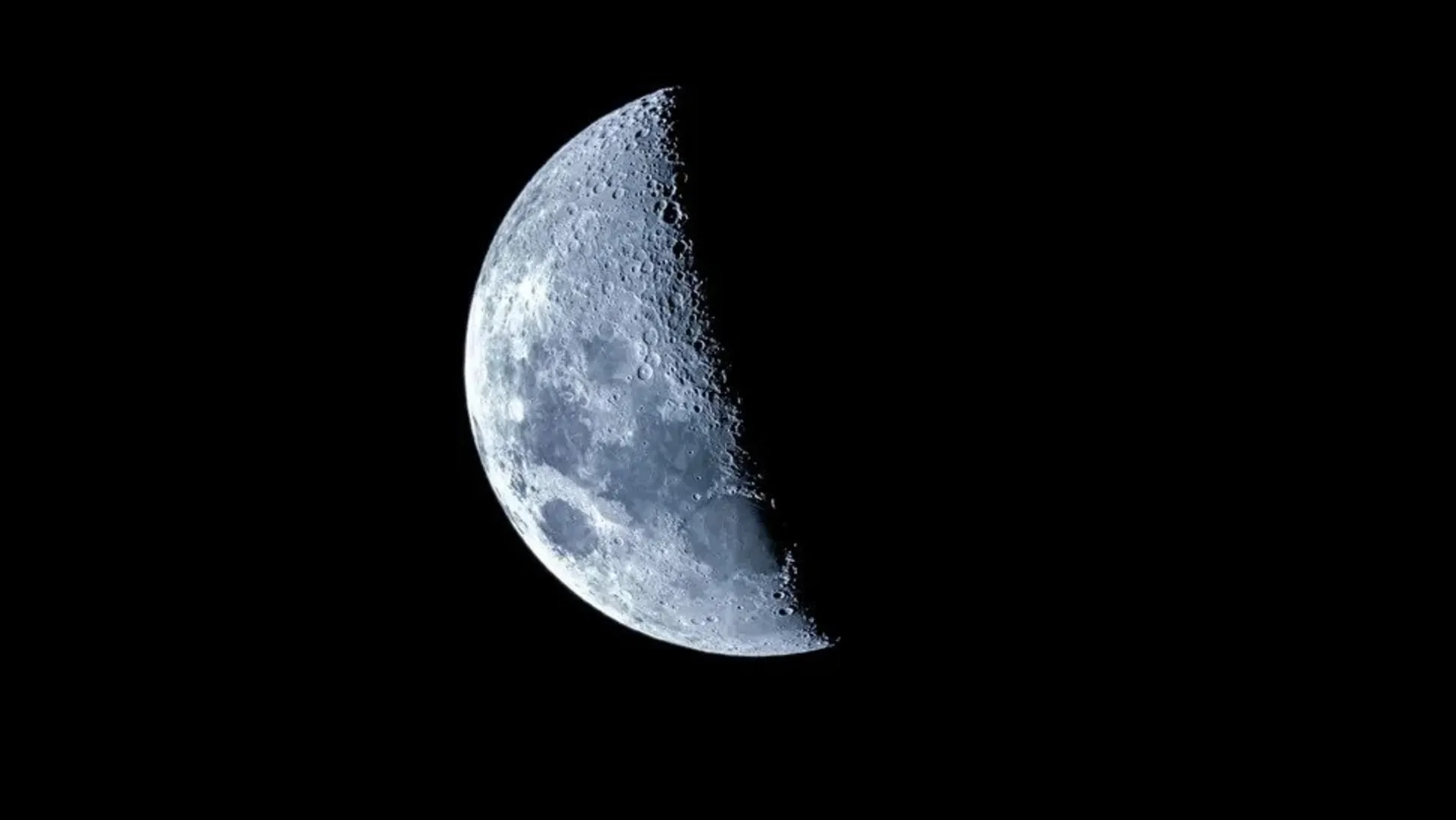 The moon was formed approximately 4.5 billion years ago.
The moon was formed approximately 4.5 billion years ago.
The distance of the moon from the earth
The average distance of the moon from the Earth is approximately 384,400 km. However, this distance is not constant because the Moon orbits the Earth in an elliptical orbit. At the closest distance of the moon from the earth, this distance decreases to 363 thousand kilometers. When the moon is at its furthest point from the earth, this distance reaches 405 thousand kilometers.
What is the moon made of?
The moon probably has a very small core that makes up only 1-2% of its mass and its diameter reaches 680 km. Most of this core is probably composed of iron, but a lot of sulfur and other elements are also found in it.
The diameter of the rocky mantle of the moon is approximately 1330 km and it is composed of iron and magnesium rocks. Magma in the mantle made its way to the moon’s surface in the past and was released through volcanic eruptions over a billion years. This eruption occurred between four billion and three billion years ago.
The thickness of the moon’s crust, which forms the lunar surface, reaches 70 km. The outermost part of the shell is broken and disorganized due to the large number of collisions.
In general, the moon, like the four inner planets of the solar system, is a rocky body and is covered with a large number of impact craters that were formed by the impact of asteroids millions of years ago.
The average composition of the lunar surface by weight is as follows: 43% oxygen, 20% silicon, 19% magnesium, 10% iron, 3% calcium, 3% aluminum, 0.42% chromium, 0.18% titanium and 0. 12 percent of manganese.
Orbiters have also discovered traces of surface water on the moon’s surface, possibly originating from beneath the surface. Continuous observations by the Lunar Reconnaissance Orbiter (LRO) show that water is more abundant on the south-facing slopes of the moon, and according to a 2017 study, the interior of the moon could also be full of water.
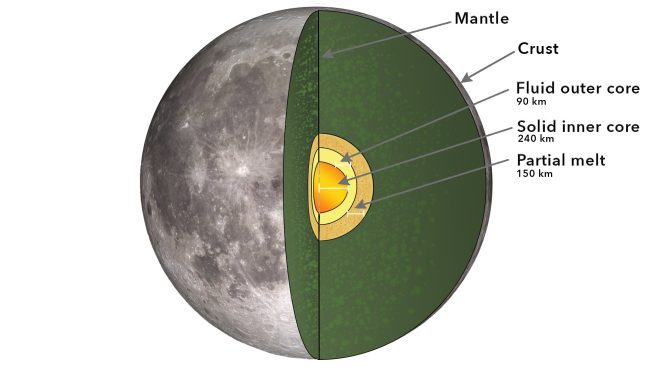

Surface characteristics of the moon
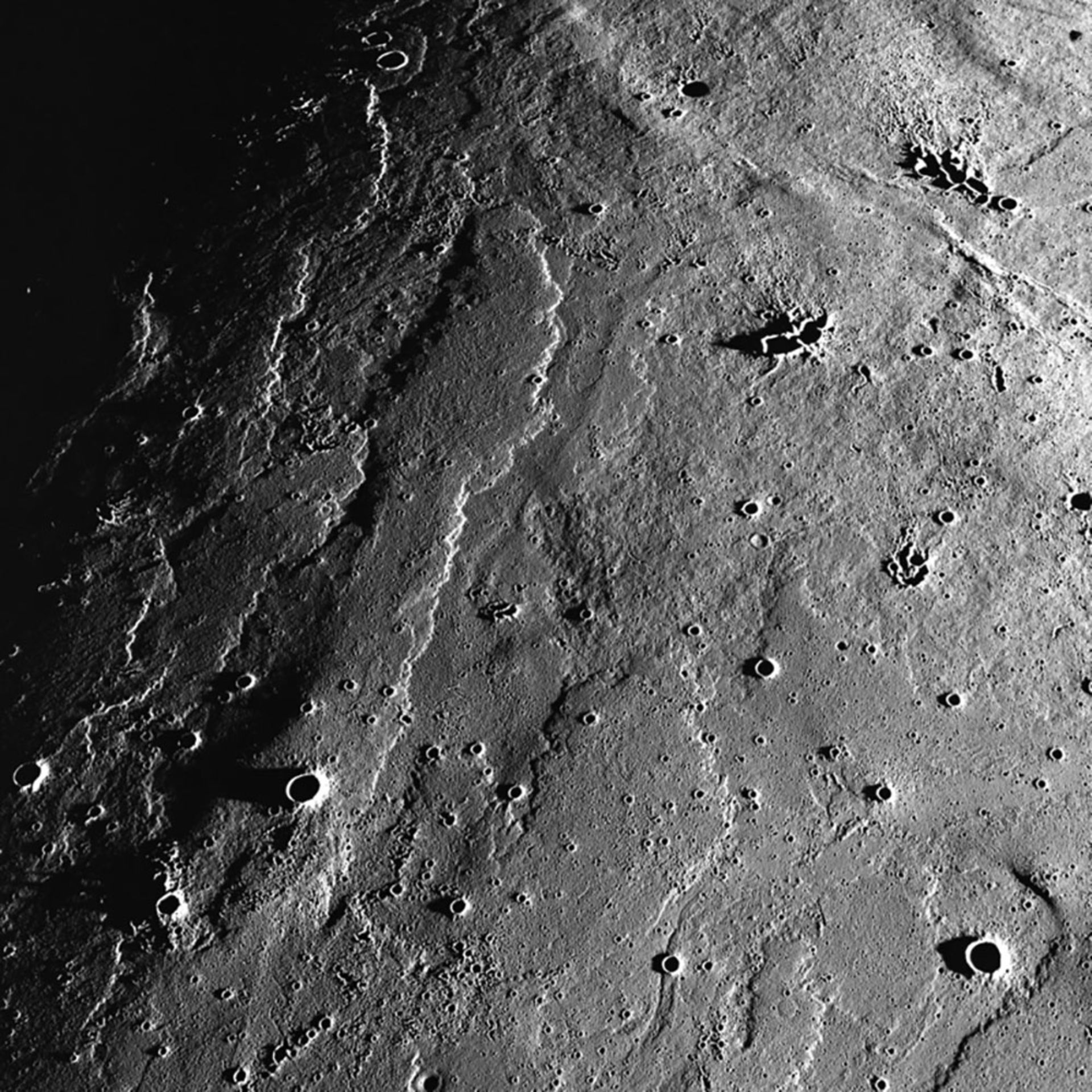 Ancient lava flows on the surface of the moon
Ancient lava flows on the surface of the moon
You can clearly see large dark areas on the surface of the moon. These areas are called “Maria” or “Maria” which is the Latin word for sea. The reason for choosing this name is that in the past people considered these areas to be seas of the moon. Today we know that these areas are actually scratches on the moon’s crust that were formed by lava flows billions of years ago.
Due to the absence of weather, almost no erosion occurs on the surface of the moon
Impact craters are other surface features of the moon. These craters are the result of meteorite and asteroid bombardment about a few billion years ago. Since the Moon has almost no atmosphere or active plate tectonics, no erosion has occurred to erase these craters, and as a result, these craters have remained unchanged since their formation.
On the other side of the moon, there is the Aitken Antarctic Basin, which is a crater with a diameter of 2,500 km and a depth of 13 km. The blue regions of the moon are located in the dark polar regions, which can be used for future exploration.
Moon’s atmosphere and weather
A very thin atmosphere covers the moon, with a density of only 100 molecules per cubic centimeter. In contrast, the Earth’s atmosphere has a billion billion times more molecules per cubic centimeter at sea level. The total mass of lunar gases reaches 25,000 kilograms, which is almost the same as a full cargo truck.
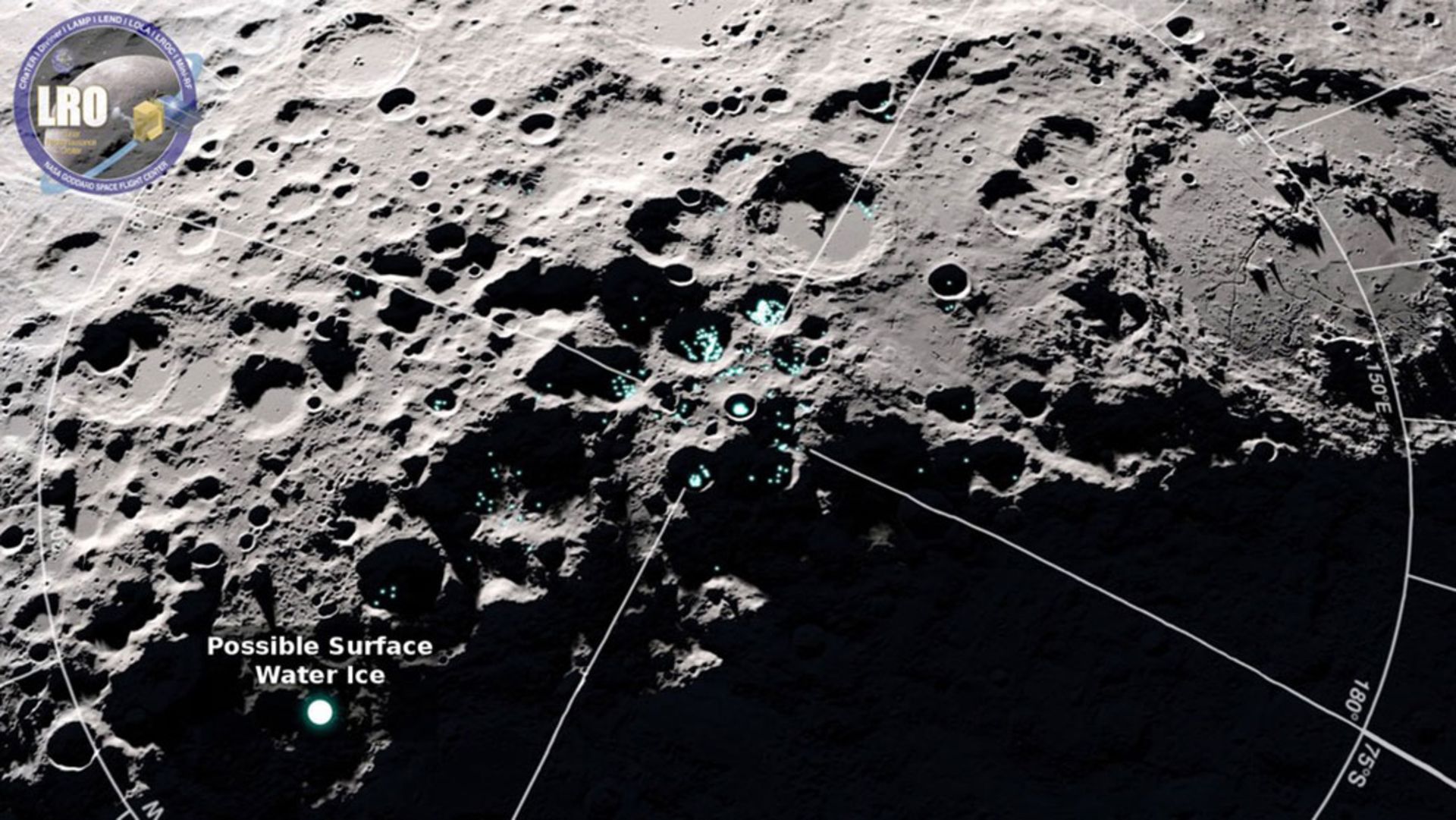 As the temperature increases, water molecules are separated from the surface and as the temperature decreases, they disperse in colder regions and the moon’s atmosphere.
As the temperature increases, water molecules are separated from the surface and as the temperature decreases, they disperse in colder regions and the moon’s atmosphere.
Moon’s atmosphere, which is also called the exosphere, is a combination of argon 40, helium 4, oxygen, methane, nitrogen, carbon monoxide, carbon dioxide, sodium, potassium, radon, polonium, and even small amounts of water. Some of these elements are left over from the cooling of the moon. Others were brought to the moon by comets.
Moondust is a combination of small and sharp particles of volcanic glass that shatter the lunar soil due to the impact of small meteors. The very thin atmosphere of the moon makes these particles rarely erode; For this reason, moon dust can damage astronauts’ equipment and clothes. This dust is extremely harmful to human health.
The orbit and phases of the moon
The influence of the moon’s gravity on the earth causes the rise and fall of the sea level or the phenomenon of tides. These tides occur on a smaller scale in lakes, the atmosphere, and even the Earth’s crust itself. The pull of the moon also slows down the speed of the earth’s rotation, which is called tidal braking; An event that increases the length of the day by 2.3 milliseconds per century. The energy that the Earth loses is absorbed by the Moon and increases its distance from the Earth. The moon moves 3.8 cm away from the Earth every year.
The moon appears in eight phases in its orbit around the Earth. One of the important points about the lunar phases is that the sun always illuminates exactly half of the moon. Lunar phases are created by changing the angle (relative positions) of the Earth, Moon, and Sun compared to each other. In simpler terms, the phase cycle of the moon can be described as follows: new moon and full moon and the phases in between.
The new moon appears when the moon is between the earth and the sun and these three bodies are in relative alignment with each other. In this case, the bright part of the moon is exactly on the other side of the moon, which terrestrial observers cannot see due to the ecliptic lock. In the full moon phase, the earth, moon and sun are in relative alignment just like the new moon phase, but this time the bright side of the moon is placed towards the earth, and the dark side is completely hidden from view.
Lunar eclipse
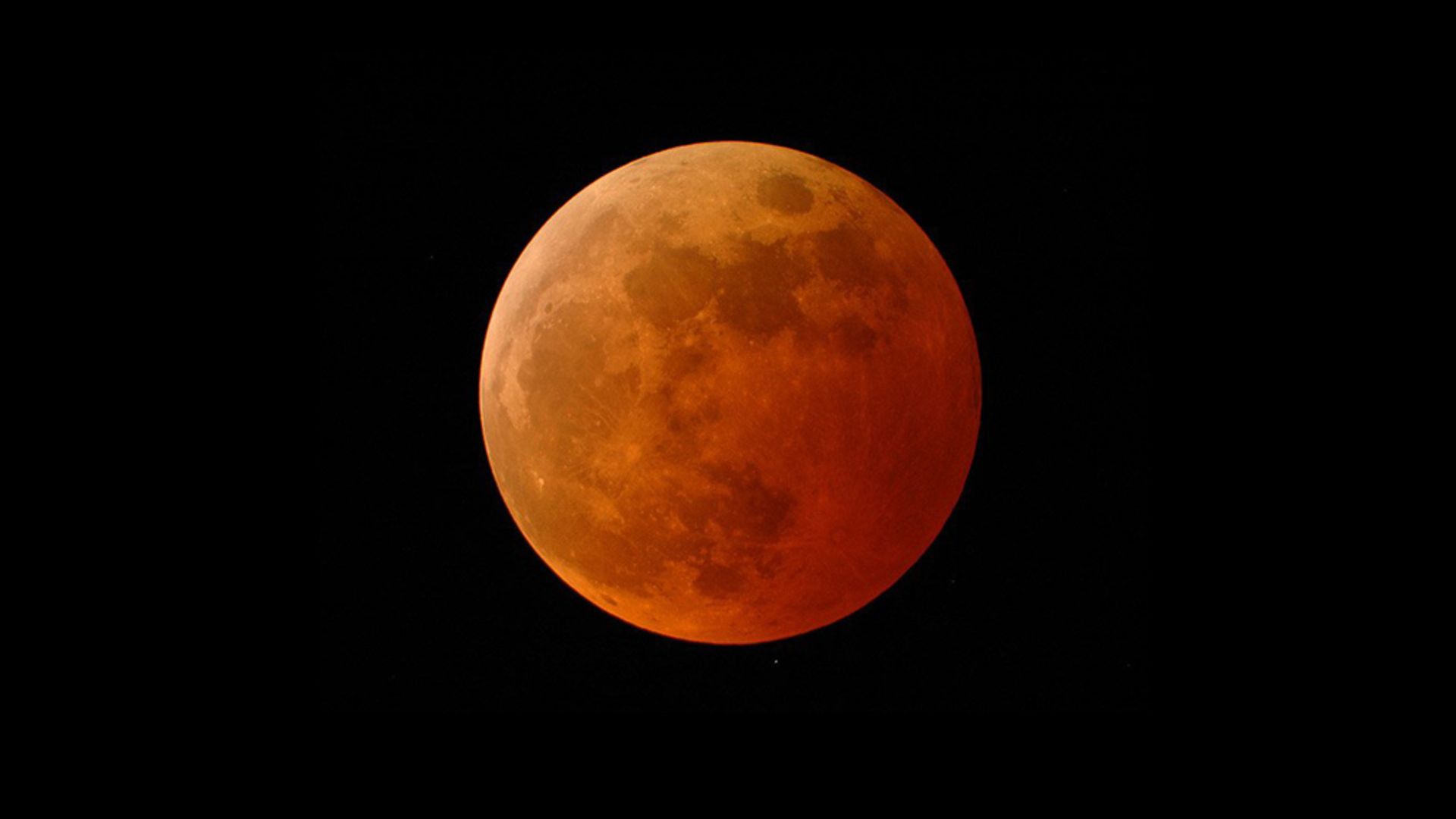 Sometimes the moon appears red during a total lunar eclipse
Sometimes the moon appears red during a total lunar eclipse
During a lunar eclipse, the Moon, Earth, and Sun are in a straight or relatively straight line. A lunar eclipse occurs when the Earth is directly between the Sun and the Moon and the Earth’s shadow falls on the face of the Moon. A lunar eclipse occurs only during a full moon. During a total lunar eclipse, the moon may appear red in the night sky because it is in shadow.
The seasons of the month
The axis of rotation of the Earth has a deviation of 23.5 degrees with respect to the plane of the ecliptic, and this issue causes the seasons on the Earth. On the other hand, the axial deviation of the moon is only 1.5 degrees, and for this reason, no significant difference can be seen in the seasons of the month. In this way, some areas of the moon are always exposed to sunlight and some areas are permanently in darkness.
Photos and images of the moon
Due to the close distance between the moon and the earth, many spacecraft and ground and space telescopes have photographed it. In this section, we introduce some of the most attractive images of the moon from different angles.
Earth rising from the moon
 A view of Earth rising from the moon captured by South Korea’s Danori spacecraft
A view of Earth rising from the moon captured by South Korea’s Danori spacecraft
The sunrise is one of the most beautiful events that can be seen from the surface of the moon. This image shows Earth’s view of the Moon as our planet rises above the lunar surface, captured by South Korea’s Danori spacecraft in November 2022.
A close-up view of the impact crater
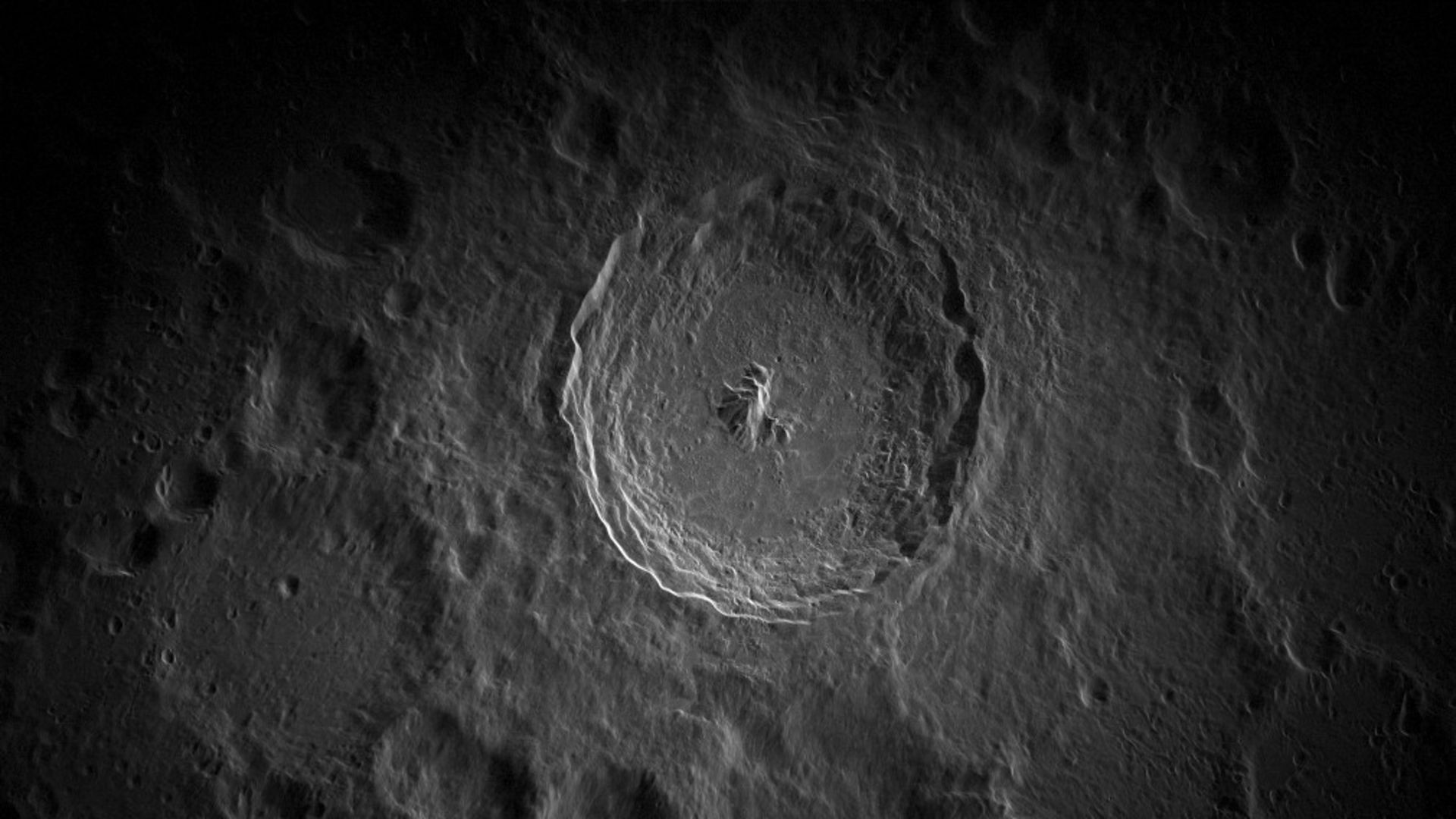 Tico impact crater
Tico impact crater
You can see a close-up of Tico’s impact crater in the image above. This massive impact crater is located on the southern side of the moon and was captured by the Greenbank Telescope in West Virginia. This photo is the most detailed image ever taken by a ground-based telescope of the lunar impact crater.
Full supermoon
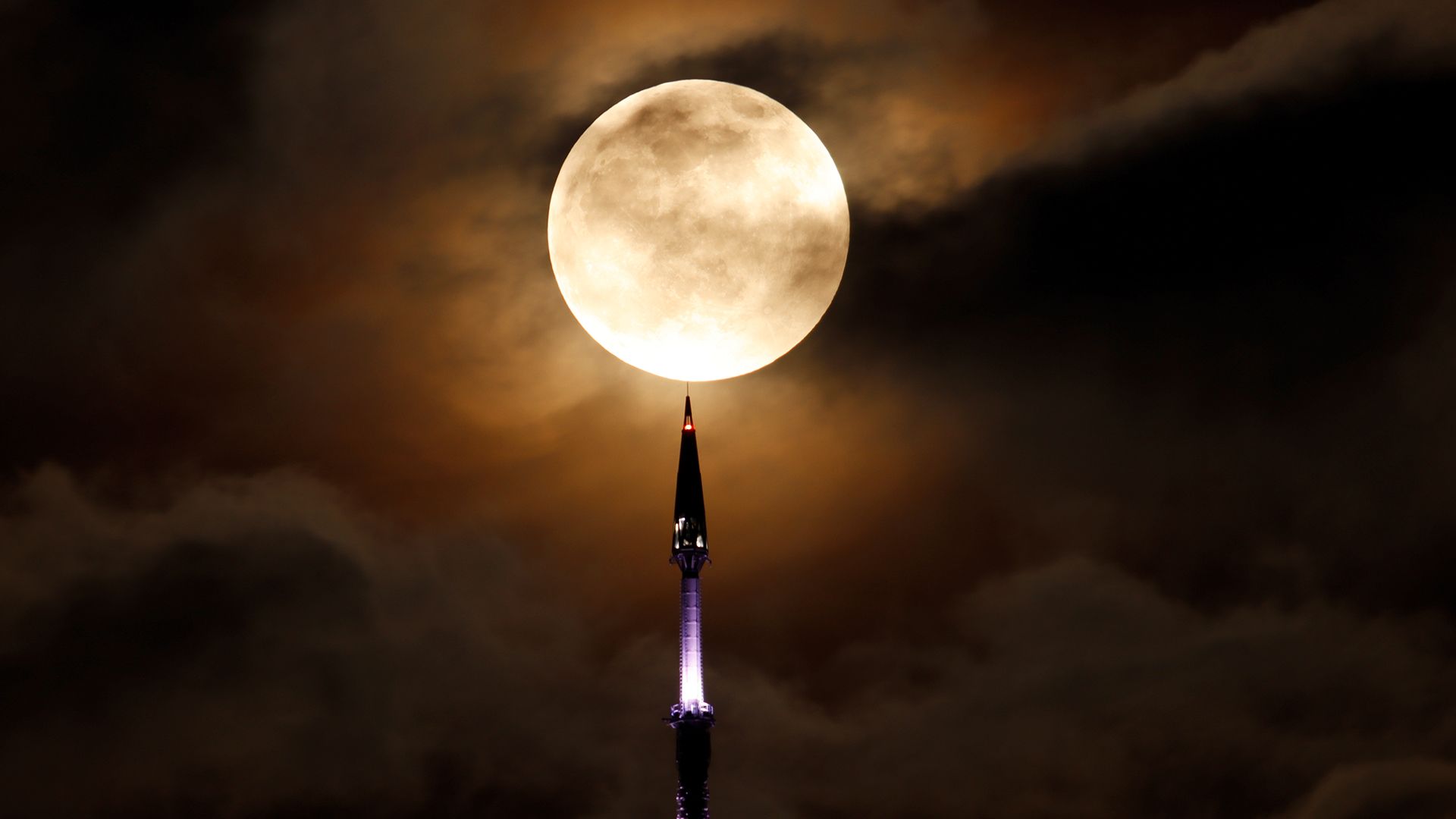 A view of the full supermoon in front of the New York World Trade Center antenna
A view of the full supermoon in front of the New York World Trade Center antenna
A full supermoon is a popular subject for many amateur and professional astrophotographers. This image shows the full supermoon in front of the World Trade Center antenna in New York City.
Apollo 10 souvenir
 The moon from the perspective of Apollo 10
The moon from the perspective of Apollo 10
The above image was captured by the Apollo 10 spacecraft in 1969. This spacecraft was NASA’s second manned spacecraft to orbit the moon and was a preparatory mission for the Apollo 11 landing, during which, for the first time in human history, astronauts landed on the surface of the moon.
The mountains of the moon
 The mountains of the moon
The mountains of the moon
In this image, you can see the mountains of the moon from the perspective of NASA’s Lunar Exploration Orbiter in 2009. Moon mountains are formed by asteroid impacts.
A station on the way to Jupiter
 Galileo probe image of the moon
Galileo probe image of the moon
This beautiful image was captured by NASA’s Galileo spacecraft on its way to Jupiter in the mid-1990s. Galileo’s main mission was to study the planet Jupiter and its moons.
Image of Artemis
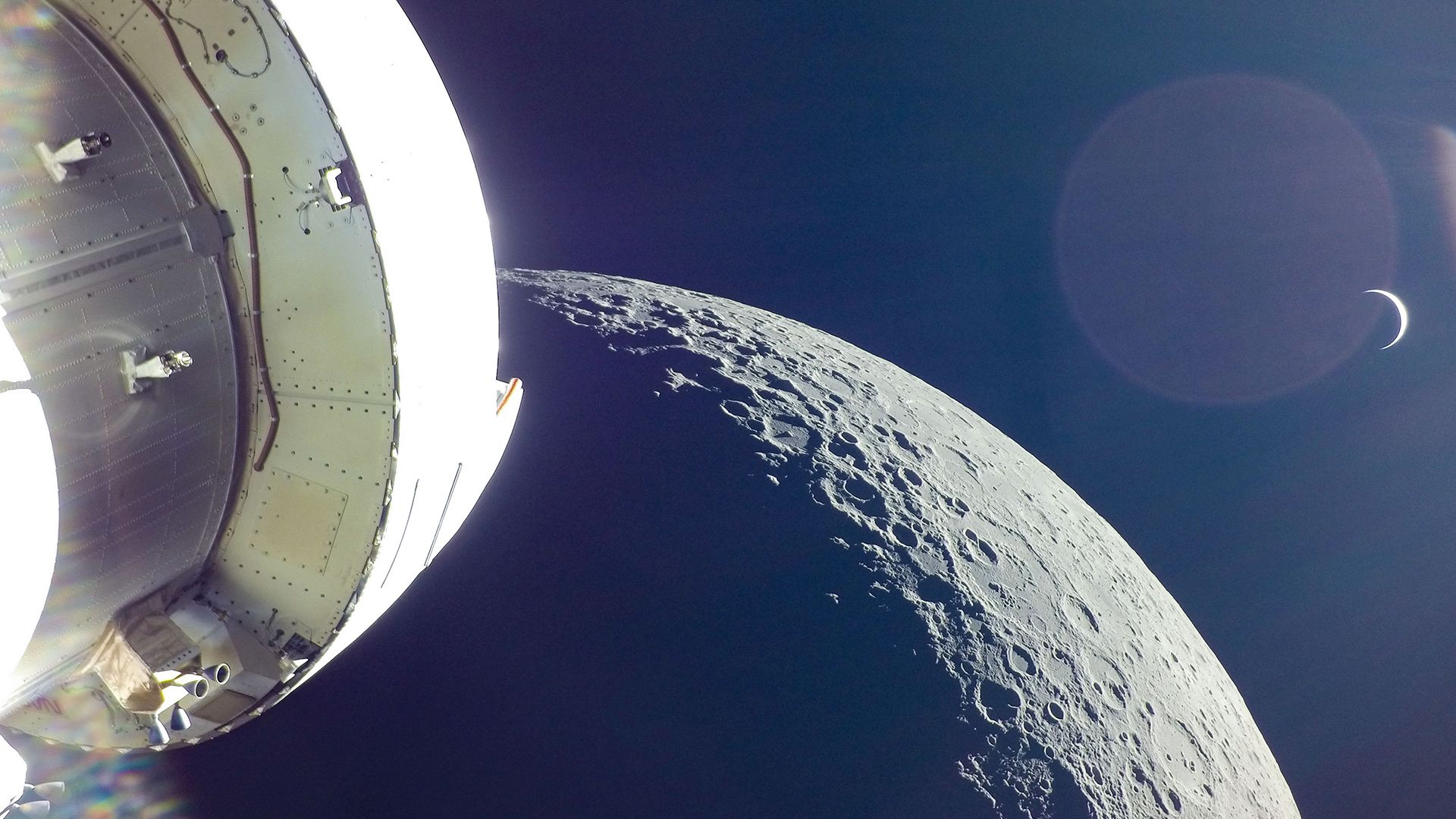 The sunrise of the earth and the moon from the perspective of Orain spacecraft
The sunrise of the earth and the moon from the perspective of Orain spacecraft
The image above shows the Earth rising from behind the Moon as captured by the Orion spacecraft on NASA’s Artemis 1 mission in 2022.
Discoveries and observations of the moon
Some ancient societies believed that the moon is a ball of fire, while others thought it was a mirror that reflected the land and seas of the earth, but according to the ancient Greek philosophers, the moon was actually a sphere that revolved around the earth and the light of the sun. reflected
The ancient Greeks also believed that the dark areas of the moon were seas and the light areas were land. It was from this time that the names “Maria” and “Ter”, the Latin words for sea and land, were chosen for these areas. Galileo Galilei, the famous Renaissance astronomer, first observed the moon using a telescope in 1609. He described surface mountains that were completely different from popular belief.
Space competition
In 1959, the Soviet Union landed the first spacecraft, Luna 2, on the surface of the moon, and in the same year, the Luna 3 spacecraft captured the first images of the far side of the moon. These missions marked the beginning of the unmanned missions of the Cold War and the Soviet-US space race to reach the moon.
The missions of many early probes were either failures or partial successes. However, over time, these missions brought back valuable information about the moon’s surface and its history. The United States launched a series of missions called Pioneer, Ranger, and Surveyor, while the Soviet Union sent probes called Luna and Zond to the moon.
 Apollo 12 lunar module
Apollo 12 lunar module
The United States sent astronauts into orbit and the surface of the moon in the 1960s and 1970s. Apollo 8 was the first manned mission to orbit the moon in 1968.
In 1969, astronauts landed on the surface of the moon during the Apollo 11 mission. Since then, five more surface missions have been successfully completed. Apollo 13 failed to land on the surface and returned home safely. Since then, the moon has remained the only space body on which humans have managed to land.
In total, the Apollo missions returned 382 kilograms of rock and soil to Earth for examination. Scientists continue to study rocks and make new discoveries as technology advances. For example, in 2013, water was discovered in Apollo 15, 16, and 17 samples.
The Soviet Union was still active in the field of robotics in the 1960s and 1970s. The first robotic sampling mission was launched with Luna 16 in September 1970 after several failed attempts. The Russians built the first robotic lunar rover named Lunakhod 1 just two months later. Lunakhod 2 was unveiled in 1973. The last successful Soviet mission to the moon was carried out in 1976 with Luna 24, and after that, the only moon of the earth was forgotten in the field of space exploration for several years.
Current missions
After the Apollo program ended more than a decade later, lunar exploration resumed in the 1990s. Since then, the space organizations of other countries such as Japan, the European Space Agency, China, and India have also joined the moon space race. China and India have succeeded so far among the new countries in the field of conquering the moon.
The future of lunar exploration
Other countries such as Japan, Russia, and the United Arab Emirates are currently planning and implementing a mission to the moon. In 2019, US President Donald Trump announced that NASA was working to send humans back to the moon by early 2025. Of course, this deadline is no longer achievable and the return of man to the moon will probably not be possible before 2028.
The Return to the Moon program, now called Artemis, is a project involving international and commercial partners that strives to carry out manned missions and permanently establish humans on the Moon, using NASA’s new space launch system, the Space Launch System (SLS), and the Starship rocket. SpaceX uses
The first Artemis mission, Artemis 1, completed an unmanned lunar orbit mission and returned to Earth in November 2022, setting the stage for subsequent manned missions. NASA’s Artemis 2 mission will send the first humans into lunar orbit in half a century, and then Artemis 3 will land the first female astronaut as well as the first person of color on the lunar surface.
Interesting facts and tips about the moon
The moon is one of the most attractive objects in the night sky for earthlings. Due to the proximity of this moon to the Earth, we can learn a lot of data about its formation and also about the planet Earth. Despite all the discoveries and research, the moon has many secrets. In this section, we introduce some examples of the most interesting facts about the month.
There are other theories about the formation of the moon
Apart from the theory of Tia’s collision with the Earth and the formation of the Moon, another theory claims that the Earth rotated so fast in its early life that its molten rocks flew into space and eventually formed the Moon. However, there is no evidence of rapid Earth rotation to support this idea. According to another theory, the moon is actually a dwarf planet similar to Pluto that is trapped in the Earth’s orbit. Scientists also reject this theory.
The moon’s atmosphere has a mysterious composition
Today we know that the moon’s atmosphere is a mixture of argon, helium, neon, sodium, polonium, potassium, and radon. However, some scientists raise the question of why, like the atmosphere of other objects, traces of oxygen and nitrogen are not seen in the moon’s atmosphere. On the other hand, the crust of the moon has both elements besides magnesium, hydrogen, and carbon. So far, scientists have not been able to find an answer to the mystery of the lack of nitrogen and oxygen in the moon’s atmosphere.
The moon has a magnetic field
One of the lesser-known facts about the moon is its magnetic field. Of course, this magnetic field is very weak compared to the Earth. Evidence from manned missions to the moon shows that the ancient moon had a magnetic field equal to that of Earth. Because of these findings, scientists believe that this magnetic field has weakened as the core of the moon has cooled and solidified.
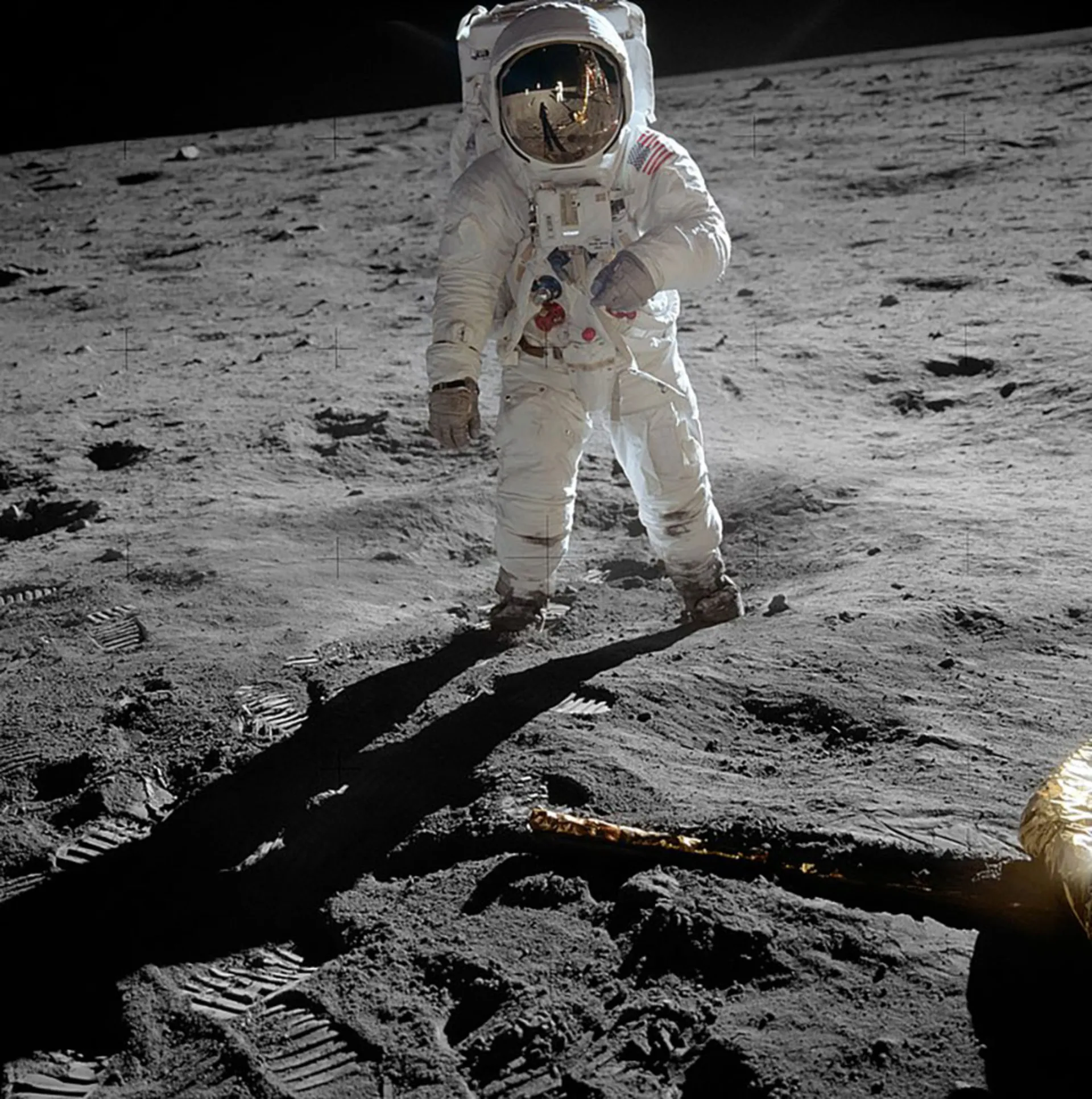 A photo of Buzz Aldrin on the moon taken by Neil Armstrong
A photo of Buzz Aldrin on the moon taken by Neil Armstrong
The moon once had a thicker atmosphere
According to a NASA discovery in 2017, the moon’s atmosphere was thicker in the past. The early moon’s atmosphere had sufficient elements despite continuous volcanic activity and a strong magnetic field. Over time, with the disappearance of volcanic activity and the weakening of the magnetic field, the solar winds destroyed the moon’s atmosphere.
Jules Verne wrote one of the most famous stories about traveling to the moon
Jules Verne, a French novelist, wrote the novel From the Earth to the Moon in 1865. The story of this novel focuses on the construction of a cylinder that can send an insulated object to the moon. Passengers are also inside this object. Finally, this cylinder is successfully built and launched. Verne describes the actual journey to the moon and the return of the passengers to Earth in the sequel to this novel, In Lunar Orbit.
Neil Armstrong was the first man to land on the surface of the moon
The Apollo 11 mission, launched on July 16, 1969, made history by landing on the lunar surface on July 20. Neil Armstrong, holding the American flag, set the record of being the first man to land on the surface of the moon. At the moment of stepping on the moon, he said this historical sentence:
A small step for a man and a giant leap for humanity
About 500 million people watched this historic moment from the ground.
NASA plans to build a base on the moon
From the beginning of this century, NASA began its plans to return to the moon by the end of the 2020s. The goal of the US space agency’s latest effort is to build the first permanent habitat on the moon by 2028. The success of this plan could have many implications for life on the Moon and other planets.
Conclusion
The moon has been the only moon of the Earth and one of the most attractive destinations for human exploration. The moon is full of impact craters that have remained unchanged for years due to the lack of weather. Also, this moon shows us only one side due to the tidal lock with respect to the Earth. Also, the gravity of the moon causes the creation of gravitational forces and so-called tides in the oceans and seas of the Earth.
Ancient people thought that the dark areas of the moon were seas and the light areas were land. However, later Galileo showed with more observations that these regions are only surface features and mountains of the moon. Competition to reach the moon intensified in the 20th century with Soviet and US missions, and finally, in 1969, the US landed the first man on the surface of the moon.
In the 21st century, mankind dreams of permanent and long-term residence on the surface of the moon. One such effort is NASA’s Artemis program, which aims to return the first humans to the moon in half a century and pave the way for permanent lunar bases.


You may like
-




Europa Clipper, NASA’s flagship probe was launched
-

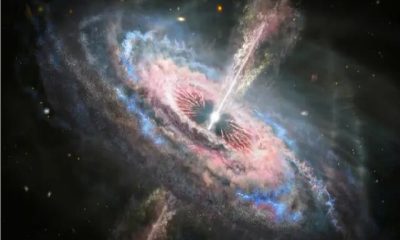


Dark matter and ordinary matter can interact without gravity!
-




James Webb Space Telescope deepens cosmology’s biggest controversy
-

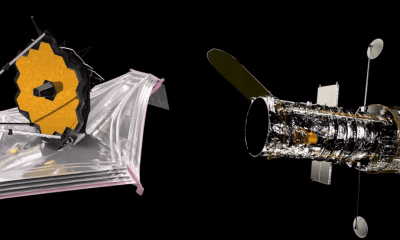


James Webb vs. Hubble
-

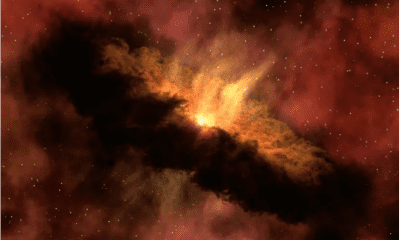


There is more than one way for planets to be born
-




Why is Jupiter one of the first targets of the James Webb Space Telescope?


Europa Clipper, NASA’s flagship probe was launched
After years of waiting, NASA’s Europa Clipper probe was finally launched on Monday at 7:36 p.m. Iran time from the Kennedy Space Center on top of SpaceX’s Falcon Heavy rocket and began a major astrobiology mission to Europa, the potentially habitable moon of Jupiter.
As SpaceX’s massive rocket powered by 27 powerful Merlin engines lifted off from pad 39A, NASA live broadcast reporter Dron Neal said, “The launch of Falcon Heavy with Europa Clipper will reveal the secrets of the vast ocean beneath the icy crust of Europa, Jupiter’s moon. It has been hidden, it will reveal.”
The engines of the two side boosters of the Falcon Heavy were shut down and separated from the central booster approximately three minutes after the flight. The central booster continued to fly for another minute, and then in the fourth minute of the launch, the separation of the upper stage from the first stage was confirmed. Finally, 58 minutes later, Europa Clipper was injected into interplanetary orbit as scheduled. A few minutes later, the mission team made contact with the probe, and people in the control room cheered and applauded.
Falcon Heavy’s unique launch
The launch of NASA’s new probe was delayed due to some mishaps. NASA and SpaceX initially planned to launch the Europa Clipper mission on Thursday, October 10; But with powerful Hurricane Milton hitting Florida’s Gulf Coast on Wednesday evening, a delay in the launch became inevitable. NASA shut down Kennedy Space Center to deal with the storm, and Europa Clipper was placed inside SpaceX’s hangar near Launch Pad 39A.
The recent launch was Falcon Heavy’s 11th flight overall and its second interplanetary mission. Also, this was the first flight of the Falcon Heavy, when all three boosters of the first stage of the rocket were deployed.
Typically, the Falcon Heavy and Falcon 9 first-stage boosters store enough fuel to perform landing maneuvers for recovery and reuse in the future; But Europa Clipper needed all the power that Falcon Heavy could provide in order to make it on its way to the Jupiter system.
A long way to the launch pad
In late 2015, the US Congress directed NASA to launch Europa Clipper using the Space Launch System (SLS), NASA’s massive rocket. SLS was still under construction at the time and was several years away from reaching the launch pad. The delay in completing the construction of this powerful rocket and NASA’s need to assign at least the first three versions of SLS to the Artemis lunar mission caused the Europa Clipper launch date to be in an aura of uncertainty.
In the 2021 House budget draft for NASA, the agency was directed to launch Europa Clipper by 2025 and, if possible, with SLS. However, due to the unavailability of the Space Launch System, NASA had to go to SpaceX’s Falcon Heavy. This decision was not without cost. As the most powerful rocket ever used in an operational mission, SLS can send Europa Clipper directly to the Jupiter system in less than three years.
Europa Clipper will use the gravitational assistance of Mars and Earth on its way to the Jupiter system
Now, even in Falcon Heavy’s fully disposable mode, the Clipper’s trip to Europe takes almost twice as long. The probe should make a flyby of Mars in February 2025 and a flyby of Earth in December 2026 to gain enough speed to reach its destination in April 2030.
Missile problems were not the only obstacles facing Europa Clipper on its way to the launch pad. For example, the rising costs of this five billion dollar probe forced NASA to cancel the construction of one of the probe’s science instruments. This instrument, named “Identification of Europa’s internal features using a magnetometer” (ICEMAG), was designed to measure Europa’s magnetic field.
Then in May 2024, NASA found that transistors similar to those used in Europa Clipper, which are responsible for regulating the probe’s electricity, were “failing at lower-than-expected radiation doses.” Following this discovery, NASA conducted more tests on the transistors and finally concluded in late August that these components could support the initial mission in the radiation-rich environment around Jupiter.
Ambitious mission to a fascinating moon

NASA/Jet Propulsion Laboratory-Caltech
Europa Clipper is one of NASA’s most exciting and ambitious flagship missions, and it has impressive features. For example, the mission probe is the largest spacecraft NASA has ever built for a planetary mission. Europa Clipper weighed almost 6,000 kg at the time of launch and will be more than 30 meters long (bigger than a basketball court) by opening its huge solar panels in space.
Clipper’s Europa destination is also a prominent location: Europa, one of Jupiter’s four Galilean moons. The moon is covered with an icy outer shell, which scientists believe hides a vast ocean of salty liquid water. For this reason, Europa is considered one of the best places in the solar system to support alien life.
In early 2012, studies began to look for potential plumes of water rising from Europa’s surface. Some researchers theorize that those water columns and vents from which the columns protrude may contain evidence of life living beneath the moon’s icy crust. However, NASA scientists have made it clear that Europa Clipper is not looking for extraterrestrial life in Europa; Rather, this probe will only investigate the potential of the submoon water environment to support life.
“If there’s life on Europa, it’s going to be under the ocean,” Bonnie Buratti, senior Europa Clipper scientist at NASA’s Jet Propulsion Laboratory, said in September. As a result, we cannot see it.” “We will be looking for organic chemicals that are prerequisites for life on the surface of the moon,” Borrati added. There are things we can observe; such as DNA or RNA; But we don’t expect to see them. As a result, [the probe] is only looking for habitable environments and evidence for the ingredients of life, rather than life itself.”
NASA scientists have made it clear that Europa Clipper is not looking for extraterrestrial life in Europa
Europa Clipper will collect data using a suite of nine scientific instruments, including visible and thermal cameras, several spectrometers, and special equipment to identify Europa’s magnetic environment. As stated on NASA’s Europa Clipper page, the probe will help scientists achieve three main goals:
- Determining the thickness of Europa’s ice sheet and understanding how Europa’s ocean interacts with the lunar surface.
- Investigating the composition of Europa’s ocean to determine whether it has the materials necessary to form and sustain life.
- Studying the formation of Europe’s surface features and discovering signs of recent geological activities; such as the sliding of crustal plates or the discharge of water columns in space.
Europa Clipper also transports Earth’s culture to the Solar System. A piece called “In Praise of Mystery: A Poem for Europe” by Edda Lemon, a famous American poet, is engraved in the artist’s own handwriting on a metal plate. In addition, the probe carries a coin-sized chip that contains the names of 2.6 million inhabitants of planet Earth.
6-year journey

Johns Hopkins University Applied Physics
If all goes according to plan, Europa Clipper will enter Jupiter’s orbit in April 2030. When the probe gets there, it will use up 50-60% of its 2,722 kg of fuel by performing an injection maneuver for 6-8 hours.
The injection maneuver puts Europa Clipper in an elliptical orbit around the gas giant. A series of long maneuvers will then be performed to align the trajectory so that the probe can fly by Europa more than 45 times and study it closely. In fact, Europa Clipper will remain around Jupiter throughout its mission; Because according to the launch environment of Europa, it will be very dangerous for the spacecraft to go around the moon.
If all goes according to plan, Europa Clipper will enter Jupiter’s orbit in April 2030
The first flight over Europe will not take place before the spring of 2031. NASA will use the first pass to make further corrections to Europa Clipper’s trajectory in preparation for the probe’s first science mission. With the start of scientific flybys in May 2031, Europa Clipper will aim its array of sensors towards the far hemisphere from Jupiter and will approach the surface of the moon up to 25 km. The second science campaign will begin two years later, in May 2033, in the Jupiter-facing hemisphere of Europa.
The end of the Europa Clipper mission is set for September 2034. At that time, NASA will crash the spacecraft into Ganymede, another Galilean moon of Jupiter. This disposal strategy was chosen because Ganymede is considered a relatively poor candidate to host life, and the mission team wanted to make sure they did not contaminate potentially life-hosting Europa with terrestrial microbes.
Space
Dark matter and ordinary matter can interact without gravity!
Published
2 weeks agoon
01/10/2024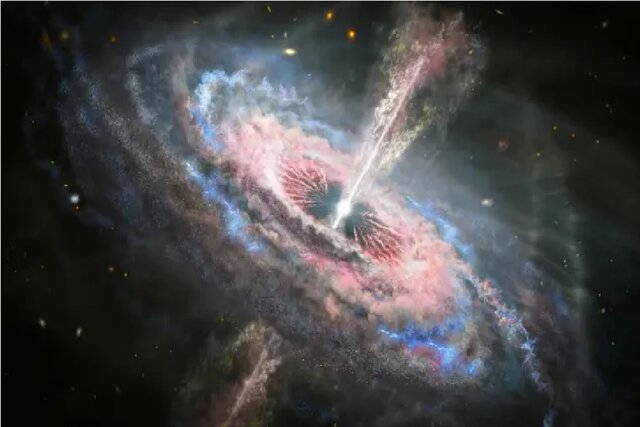

Preposition: For each; per.
Noun: A topology name.
Noun: which has mass but which does not readily interact with normal matter except through gravitational effects.
Adverb: Beyond all others.
Preposition: For each; per.
Noun: A topology name.
Dark matter and ordinary matter can interact without gravity!
Why is dark matter associated with the adjective “dark”? Is it because it harbors some evil forces of the universe or hidden secrets that scientists don’t want us to know? No, it is not. Such fanciful assumptions may sound appealing to a conspiracy theorist, but they are far from the truth.
Dark matter is called dark because it does not interact with light. So when dark matter and light collide, they pass each other. This is also why scientists have not been able to detect dark matter until now; it does not react to light.
Although it has mass and mass creates gravity, this means that dark matter can interact with normal matter and vice versa. Such interactions are rare, and gravity is the only known force that causes these two forms of matter to interact.
However, a new study suggests that dark matter and ordinary matter interact in ways other than gravity.
If this theory is correct, it shows that our existing models of dark matter are somewhat wrong. In addition, it can lead to the development of new and better tools for the detection of dark matter.
Read more: There is more than one way for planets to be born
A new missing link between dark and ordinary matter
Dark matter is believed to have about five times the mass of normal matter in our universe, which helps hold galaxies together and explains some of the motions of stars that don’t make sense based on the presence of visible matter alone.
For example, one of the strongest lines of evidence for the existence of dark matter is the observation of rotation curves in galaxies, which show that stars at the outer edges of spiral galaxies rotate at rates similar to those near the center. These observations indicate the presence of an invisible mass.
Also, for their study, the researchers studied six ultra-dim dwarf (UFD) galaxies located near the Milky Way. However, in terms of their mass, these galaxies have fewer stars than they should. This means they are mostly made up of dark matter.
According to the researchers, if dark matter and normal matter interact only through gravity, the stars in these UFDs should be denser in the centers and more spread out toward the edges of the galaxies. However, if they interact in other ways, the star distribution looks different.
The authors of the study ran computer simulations to investigate both possibilities. When they tested this for all six ultra-dim dwarf (UFD) galaxies, they found that the distribution of stars was uniform, meaning that the stars were spread evenly across the galaxies.
This was in contrast to what is generally observed for gravitational interactions between dark matter and normal matter.
What causes this interaction?
The results of the simulations showed that gravity is not the only force that can make dark matter and normal matter interact. Such an interaction has never been observed before, and it could change our understanding of dark matter and dark energy.
However, this study has a major limitation. What caused the interaction between the two forms of matter is still a mystery. While the current study provides tantalizing hints of a novel interaction, its exact nature and underlying causes remain unknown. Hopefully, further research will clarify the details of such interactions.
This study was published in The Astrophysical Journal Letters.
Space
James Webb Space Telescope deepens cosmology’s biggest controversy
Published
3 weeks agoon
26/09/2024

How the James Webb Space Telescope deepens cosmology’s biggest controversy
Summary of the article:
- Almost a century ago, Edwin Hubble discovered the expansion of the universe and calculated the expansion rate or the cosmic constant.
- Since Hubble, many groups have tried to measure the expansion rate of the universe. However, the values they obtained differed from the theoretical predictions. This difference is called Hubble tension.
- Scientists today use three methods to measure the expansion rate of the universe: Cephasian variable stars, TRGB red giant stars, and JAGB asymptotic giants.
- However, the Hubble tension still exists, indicating that the methods for calculating the Hubble constant suffer from a systematic flaw.
- Researchers hope to be able to use the James Webb telescope in the coming years to achieve more accurate measurements of the universe’s expansion rate and thus resolve the Hubble tension.
Almost a century ago, Edwin Hubble discovered that the universe was getting bigger. However, today’s measurements of how fast the universe is expanding are contradictory. These discrepancies show that our understanding of the laws of physics may be incomplete. On the other hand, everyone expected the sharp eyes of the James Webb telescope to bring us closer to the answer to the riddle; But a new analysis of the telescope’s long-awaited observations once again reflects inconsistent expansion rates from different types of data, while pointing to possible sources of error.
Two competing groups have led efforts to measure the rate of expansion of the universe, known as Hubble’s constant, or H0. A group led by Adam Reiss of Johns Hopkins University, relying on the known constituents of the universe and the governing equations, has consistently calculated the Hubble constant to be approximately 8 percent higher than the theory predicts the universe’s expansion rate. This discrepancy, known as the Hubble tension, indicates that the model of the cosmological theory may have missed some elements such as raw materials or effects that speed up the expansion of the universe. Such an element can be a clue to a more complete understanding of the world.
This spring, Reiss and his team published new measurements of the Hubble constant based on data from the James Webb Telescope and found a value consistent with their previous estimates. However, a rival group led by Wendy Friedman of the University of Chicago warns that more precise measurements are needed. The team’s measurements of the Hubble constant are closer to the theoretical estimate than Riess’ calculations, suggesting that the Hubble stress may not be real.
Since the commissioning of the James Webb Telescope in 2022, the astrophysical community has been waiting for Friedman’s multidimensional analysis based on telescope observations of three types of stars. The results are now as follows: the two-star types provide estimates of the Hubble constant that are in line with the theoretical prediction; While the results of the third star, which is the same type used by Reiss, are consistent with his team’s higher estimates of Hubble’s constant. According to Friedman, the fact that the results of the three methods are contradictory does not mean that there are unknown physical foundations, but that there are some systematic errors in the calculation methods.
Contradictory world
The difficult part of measuring cosmic expansion is measuring the distance of space objects. In 1912, American astronomer Henrietta Levitt first used pulsating stars known as Cephasian variables to calculate distances. These stars flicker at a rate proportional to their intrinsic luminosity. By understanding the luminosity or radiant power of a Cephasian variable, we can compare it with its apparent brightness or dimming to estimate its galaxy’s distance from us.
Edwin Hubble used Levitt’s method to measure the distances to a set of galaxies hosting the Cephasian variable, and in 1929 he noticed that the galaxies that are farther away from us are moving away faster. This finding meant the expansion of the universe. Hubble calculated the expansion rate to be a constant value of 500 km/s per megaparsec. In other words, two galaxies that are 1 megaparsec or approximately 3.2 million light years apart are moving away from each other at a speed of 500 km/s.
As progress was made in calibrating the relationship between the pulsation frequency of Cepheids and their luminosity, measurements of the Hubble constant improved. However, since the Cephasian variables are very bright, the whole approach used has limitations. Scientists need a new way to measure the distance of galaxies from each other in the infinite space.
In the 1970s, researchers used Cephasian variables to measure the distance to bright supernovae, and in this way they achieved more accurate measurements of the Hubble constant. At that time, as now, two research groups undertook the measurements, and using supernovae and Cephasian variable stars, they achieved contradictory values of 50 km/s per megaparsec and 100 km/s per megaparsec. However, no agreement was reached and everything became completely bipolar.
 Edwin Hubble, the American astronomer who discovered the expansion of the universe, stands next to the Schmidt telescope at the Palomar Observatory in this photo from 1949.
Edwin Hubble, the American astronomer who discovered the expansion of the universe, stands next to the Schmidt telescope at the Palomar Observatory in this photo from 1949.
The launch of the Hubble Space Telescope in 1990 gave astronomers a new and multi-layered view of the universe. Friedman led a multi-year observing campaign with Hubble, and in 2001 he and his colleagues estimated the expansion rate to be 72 km/s/Mpa with an uncertainty of at most 10%.
A Nobel laureate for the discovery of dark energy, Reiss got into the expansion game a few years later. In 2011, his group found the Hubble constant to be 73 with a three percent uncertainty. Soon after this, cosmologists excelled in another way. In 2013, they used Planck’s observations of light left over from the early universe to determine the exact shape and composition of the early universe.
In the next step, the researchers connected their findings to Einstein’s theory of general relativity and developed a theoretical model to predict the current state of the universe, up to approximately 14 billion years into the future. Based on these calculations, the universe should be expanding at an approximate rate of 67.4 km/s per megaparsec with an uncertainty of less than one percent.
Reese’s team measurement remained at 73, even with the improved accuracy. This higher value indicates that the galaxies today are moving away from each other at a faster rate than theoretically expected. This is how the Hubble tension was born. According to Reiss, today’s Hubble tension shows us that something is missing in the cosmological model.
The missing factor could be the first new element in the universe to be discovered since dark energy. Theorists still have doubts about the identity of this agent. Perhaps this force is some kind of repulsive energy that lasted for a short time in the early universe, or perhaps it is the primordial magnetic fields created during the Big Bang, or perhaps what is being missed is more about ourselves than the universe.
Ways of seeing
Some cosmologists, including Friedman, suspected that unknown errors were to blame for Hubble’s tension. For example, Cephasian variable stars are located in the disks of younger galaxies in regions full of stars, dust, and gas. Even with Hubble’s fine resolution, you don’t see a single Cephasian variable, according to George Afstatio, an astrophysicist at the University of Cambridge. Rather, you see it overlapping with other stars. This density of stars makes measurements of brightness difficult.
When the James Webb Telescope launches in 2021, Reiss and his colleagues will use its powerful infrared camera to peer into the crowded regions that host the Cephasian variables. They wanted to know whether the claims of Friedman and other researchers about the effect of the area’s crowding on the observations were correct.
 The 6.5-meter multi-section mirror of the James Webb Space Telescope at NASA’s Goddard Space Flight Center in Maryland. This mirror passed various test stages in 2017.
The 6.5-meter multi-section mirror of the James Webb Space Telescope at NASA’s Goddard Space Flight Center in Maryland. This mirror passed various test stages in 2017.
When the researchers compared the new numbers to distances calculated from Hubble data, they saw a surprising match. The latest results from the James Webb telescope confirmed the Hubble constant measured by the Hubble telescope a few years ago: 73 km/s/Mpa with a difference of one kilometer or so.
Concerned about crowding, Friedman turned to alternative stars that could serve as distance indicators. These stars are found in the outer reaches of galaxies and away from the crowd. One of those stars belongs to the group ” Red Giant Branch ” or TRGB for short. A red giant is an old star with a puffy atmosphere that shines brightly in the red light spectrum. As a red giant ages, it eventually burns helium in its core, and at this point, the star’s temperature and brightness suddenly decrease.
A typical galaxy has many red giants. If you plot the brightness of these stars against their temperature, you reach a point where the brightness drops off. The star population before this brightness drop is a good distance indicator; Because in each galaxy, such a population has a similar distribution of luminosity. By comparing the brightness of these star populations, astronomers can estimate their relative distances.
The Hubble tension shows that the standard model of the cosmos is missing something
Regardless of the method used, physicists must calculate the absolute distance of at least one galaxy as a reference point in order to calibrate the entire scale. Using TRGB as a distance index is more complicated than using Kyphousian variables. MacKinnon and colleagues used nine wavelength filters from the James Webb telescope to understand how brightness relates to their color.
Astronomers are also looking for a new indicator: carbon-rich stars that belong to a group known as the “Jay region asymptotic giant” (JAGB). These stars are far from the bright disk of the galaxy and emit a lot of infrared light. However, it was not possible to observe them at long distances until James Webb’s launch.
Friedman and his team have applied for observation time with the James Webb Space Telescope in order to observe TRGBs and JAGBs, along with more fixed spacing indices and Cephasian variables, in 11 galaxies.
The vanishing solution
On March 13, 2024, Friedman, Lee, and the rest of the team meet in Chicago to find out what they’ve been hiding from each other. Over the past months, they were divided into three groups, each tasked with measuring distances to 11 galaxies using one of three methods: Cephasian variable stars, TRGBs, and JAGBs.
These galaxies also host related types of supernovae, so their distances can calibrate the distances of supernovae in many more distant galaxies. The rate at which galaxies move away from us divided by their distance gives the value of the Hubble constant.
 Wendy Friedman at the University of Chicago is trying to fit the James Webb Telescope observations into the Standard Cosmological Model.
Wendy Friedman at the University of Chicago is trying to fit the James Webb Telescope observations into the Standard Cosmological Model.
Three groups of researchers calculated distance measures with a unique, random counterbalancing value added to the data. During the face-to-face session, they removed those values and compared the results.
All three methods obtained similar distances with three percent uncertainty. Finally, the group calculated three values of Hubble’s constant for each distance index. All values were within the theoretical prediction range of 67.4. Therefore, Hubble’s tension seemed to be resolved. However, they ran into problems with further analysis to write the results.
The JAGB analysis was good, But the other two were wrong. The team found that there were large error bars in the TRGB measurements. They tried to minimize the errors by including more TRGBs; But when they started doing this, they found that the distance to the galaxies was less than they first thought. This change caused the value of Hubble’s constant to increase.
Friedman’s team also discovered an error in Cephaus’s analysis: in almost half of the pulsating stars, the term crowd was applied twice. Correcting this error increased the value of Hubble’s constant significantly. Hubble’s tension was revived.
Finally, after efforts to fix the errors, the researchers’ paper presents three distinct values of Hubble’s constant. The JAGB measurement yielded a result of 67.96 km/s/megaparsec. The TRGB result was equal to 69.85 with similar error margins. Hubble’s constant was obtained at a higher value of 72.05 in the Kyphousian variable method. In this way, different hypotheses about the characteristics of these stars caused Hubble’s stress value to vary from 69 to 73.
By combining the aforementioned methods and uncertainties, the average Hubble stress value equal to 69.96 was obtained with an uncertainty of four percent. This margin of error overlaps with the theoretical prediction of the expansion rate of the universe, as well as the higher value of Tim Reiss.
Tensions and resolutions
The James Webb Space Telescope has provided methods for measuring the Hubble constant. The idea is simple: closer galaxies look more massive; Because you can make out some of their stars, while more distant galaxies have a more uniform appearance.
A method called gravitational convergence is more promising. A massive galaxy cluster acts like a magnifying glass, bending and magnifying the image of a background object, creating multiple images of the background object when its light takes different paths.
Brenda Fry, an astronomer at the University of Arizona, is leading a program to observe seven clusters with the James Webb Space Telescope. Looking at the first images they captured last year of the G165 cluster, Fry and his colleagues noticed three spots that were not previously seen in the images. These three points were actually separate images of a supernova that was located in the background of the aforementioned cluster.
After repeating the observation several times, the researchers calculated the difference between the arrival times of the three gravitational lensing images of the supernova. This time delay is proportional to Hubble’s constant and can be used to calculate this value. The group obtained an expansion velocity of 75.4 km/s/Mpa with a large uncertainty of 8.1%. Fry expects the error bars to correct after several years of similar measurements.
Both Friedman’s and Reiss’ teams predict that they will be able to get a better answer with James Webb’s observations in the coming years. “With improved data, the Hubble tension will eventually be resolved, and I think we’ll get to the bottom of it very quickly,” Friedman says.


Biography of Geoffrey Hinton; The godfather of artificial intelligence


The Secret of the Hummingbird’s Amazing Adaptation


Europa Clipper, NASA’s flagship probe was launched


How did accidental release cause the 1977 Russian flu?


Everything about Cybercube and Robo Van; Elon Musk’s robotic taxis


The Strawberry Project; The OpenAI artificial intelligence model


The biography of Andy Rubin, the creator of Android


Why doesn’t Jupiter have big and bright rings like Saturn?


Everything you need to know about the Windows Blue Screen of Death


How to prevent your location from being revealed through photos?
Popular
-



 Technology1 year ago
Technology1 year agoWho has checked our Whatsapp profile viewed my Whatsapp August 2023
-



 Technology1 year ago
Technology1 year agoSecond WhatsApp , how to install and download dual WhatsApp August 2023
-



 Technology1 year ago
Technology1 year agoHow to use ChatGPT on Android and iOS
-



 AI2 years ago
AI2 years agoUber replaces human drivers with robots
-



 Technology1 year ago
Technology1 year agoThe best Android tablets 2023, buying guide
-



 Technology1 year ago
Technology1 year agoThe best photography cameras 2023, buying guide and price
-



 Humans2 years ago
Humans2 years agoCell Rover analyzes the inside of cells without destroying them
-



 Technology1 year ago
Technology1 year agoHow to prevent automatic download of applications on Samsung phones
